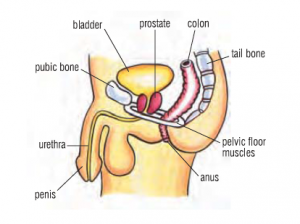Incontinence can often be a barrier to an individual’s participation in sport and fitness activities. However, it may come as a surprise to hear that exercise can actually be a form of treatment for incontinence.
Strengthening the pelvic floor muscles through exercise has been proven through various research to be effective in treating incontinence in both women and men. In the past, Kegel exercises were often promoted by physicians to female patients only, however, in the recent years they are now being promoted to men in an effort to improve male incontinence. Health professional Kari Bo reports, “pelvic floor muscle training has no serious adverse effects on health and has been recommended as first-line treatment for incontinence in men”.

Although many men refuse to acknowledge that they have a problem with incontinence, practising exercises can save you from a lifetime of challenges and anxiety. Exercising the pelvic floor muscles soon after treatments for prostate diseases has the potential to rapidly reduce male incontinence. According to incontinence expert Tatyana Shamliyan, frequent pelvic floor muscle exercises and biofeedback could even result in 180 additional cases of incontinence per 1000 being treated. Health professionals have also estimated that an early pelvic floor muscle rehabilitation program after radical prostatectomy would result in 107 additional cases of continence being treated per 1000 men. A study taking place in between 1995 and 1998 confirmed that long-term improvement in faecal incontinence can be achieved through treatment with biofeedback and pelvic floor exercises. In this study, 120 men suffering with faecal incontinence were referred by 6 colorectal surgeons to a treatment program involving pelvic floor exercises at the Royal Prince Alfred Hospital in Sydney. The program involved five monthly sessions with an experienced clinical nurse specialist, including frequent pelvic floor exercises. More than 70% of the patients reported a significant improvement in their incontinence.
Why does strengthening the Pelvic Floor Muscles treat Incontinence?
To understand why we do pelvic floor exercises, it is useful to understand the relationship between weak pelvic floor muscles and incontinence. The pelvic floor muscles are the layer of muscles that support the pelvic organs and span the bottom of the pelvis, forming a muscular support across its base. In men, the pelvic floor muscles support the bladder and bowel. Sphincters at the base of the bladder and underneath the prostate gland help to prevent urine leakage. The anal sphincter at the base of the back passage maintains bowel control. Portions of the pelvic floor muscles wrap around these valves to assist them in staying closed. These muscles help to hold your organs in place, promoting good bladder control and sexual function. Having weak pelvic floor muscles means that the internal organs are not fully supported, making it difficult or impossible to control the release of urine or faeces. Men are much less affected by a weakened pelvic floor than women due to their anatomy. However, pelvic floor muscles in men can be weakened by constipation, being overweight, heavy lifting and not being fit. It is important for men of all ages to have strong pelvic floor muscles so they can maintain continent.
Pelvic Floor Muscle Exercises, also known as Kegel Exercises, were discovered in 1948 by Dr. Arnold Kegel. Although the practice of the exercises has been around for a while, many of us do not fully understand the benefits of the exercises and how they work.

Location of the Pelvic Floor Muscles in Men
Practicing Kegel Exercises
To find your pelvic floor, simply try and stop the flow of urine in mid-stream or imagine trying to avoid passing wind by squeezing inside and pulling upwards. Hold the contraction for three seconds and then relax for three seconds. If you feel a lifting or pulling sensation, you are performing the exercises correctly. It is helpful to then stand in front of a mirror. When you do a pelvic floor muscle contraction you should see the base of your penis draw inwards and your testicles/scrotum lift. In order to check your pelvic floor muscles are working correctly, place your fingers on your perineum, the area between the anus and the scrotum or vulva. You should feel the perineum lift upwards as you contract your muscles.
Tips for performing Kegel Exercises:
- Try not to hold your breath or cross your legs whilst doing these exercises
- Do not tense the muscles in your buttocks, abdomen or legs
- Continue doing the exercises daily for maximum effect.
- Ensure you are aware of which muscles are being contracted. When you first start doing these exercises, you may begin to use other muscles to help. However, it is important to become aware of which muscles are being contracted for safety and to ensure maximum effect.
If you do Kegels three times a day, you should see better bladder control in three to six weeks. Urologists can offer additional tips on how to find and exercise the right muscles.
Staying active to improve Incontinence
Being overweight can weaken your pelvic floor muscles and can cause incontinence, due to pressure of fatty tissue on the bladder. It is estimated that the risk of urinary incontinence increases by 7 to 12% for each 1 kg unit increase in for BMI. Your symptoms may improve and could clear up completely if you lose the excess weight. You should therefore not avoid doing exercises due to fear of those small leakages. Urologist Roger Dmochowski asserts, “unfortunately, people stop doing things they enjoy due to incontinence, such as high-impact aerobics”. There are forms of exercise you can do however that are low-impact activities such as cycling, hiking, swimming, walking and yoga that can drastically improve your incontinence.
If you wish to continue a sport that has a high risk of leakages, you can do Kegel exercises before and during your workout.

Originally posted 2018-01-10 11:46:36.












Leave a Reply